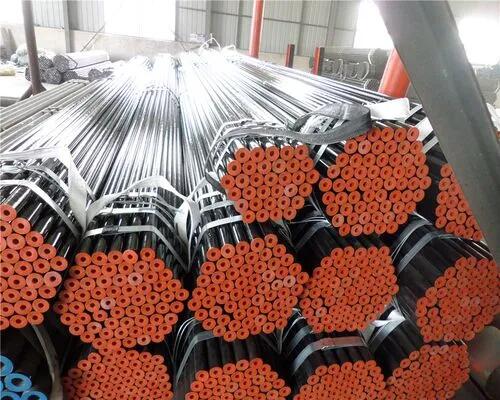
Anti-corrosion Methods of Seamless Steel Pipes
Date:2024-06-25 keywords: seamless steel pipe anti-corrosion method, seamless steel tube anti-corrosion coating, smls pipe
What are the anti-corrosion methods for seamless steel pipes?
There are various anti-corrosion treatment methods for seamless steel pipes (SMLS pipe), and different anti-corrosion materials and treatment methods can be selected according to different uses and environments. Anti-corrosion treatment can effectively extend the service life of seamless steel pipes, reduce maintenance costs and improve safety. Let’s follow the seamless steel pipe supplier to learn more about the anti-corrosion methods of seamless steel pipes.
1. External anti-corrosion coating
2. Internal anti-corrosion coating
Internal anti-corrosion coating refers to coating the inner wall of a seamless pipe with a layer of anti-corrosion material to protect the inner wall of the pipe from corrosion. Commonly used internal coating anti-corrosion materials include epoxy coating, epoxy glass cloth, polyurethane, etc. This method can effectively prevent oxidative corrosion inside the pipe wall or at the interface, and can effectively avoid damage caused by corrosion of seamless pipes when transporting corrosive liquid chemical media such as acids and alkalis.
3. Galvanized anti-corrosion
The galvanizing anti-corrosion method uses the hot-dip galvanizing process to coat a layer of zinc on the surface of the seamless steel pipe to achieve the purpose of anti-corrosion. Galvanized anti-corrosion coating has good corrosion resistance, long service life, and can improve the mechanical properties and operating temperature range of steel pipes.
4. Spray anti-corrosion
The spray anti-corrosion method refers to using spray equipment to evenly spray anti-corrosion coating on the surface of seamless steel pipes to form a layer of anti-corrosion coating with uniform thickness and dense structure. Common spray anti-corrosion coatings include acrylate, alkyd resin, chlorinated rubber, etc. This method is easy to construct, has good anti-corrosion effect and has long service life.
5. Electrodialysis
Electrodialysis works by coating a conductive layer on the pipe wall, and then applying a certain voltage to the pipe wall, causing metal ions to migrate into the pipe and react with the cathode to form a tough film, forming a passive protection. Electrodialysis anti-corrosion is considered an ideal anti-corrosion measure for seamless pipes. It not only prevents corrosion, but also enhances the mechanical properties of the metal.
6. Cathodic protection
Cathodic protection refers to applying electric current to the surface of seamless pipes to turn the pipe wall into a cathode, thereby achieving the purpose of anti-corrosion. Cathodic protection can be carried out in two ways: physical protection and electrochemical protection. Electrochemical protection is divided into two types: current method and potential method. Cathodic protection is a reliable, economical and environmentally friendly seamless pipe anti-corrosion technology. It is widely used because of its simple operation and low cost.
There are various anti-corrosion treatment methods for seamless steel pipes (SMLS pipe), and different anti-corrosion materials and treatment methods can be selected according to different uses and environments. Anti-corrosion treatment can effectively extend the service life of seamless steel pipes, reduce maintenance costs and improve safety. Let’s follow the seamless steel pipe supplier to learn more about the anti-corrosion methods of seamless steel pipes.
1. External anti-corrosion coating
External anti-corrosion coating is one of the most common anti-corrosion measures for seamless steel pipes. It coats the outer surface of the pipe with a layer of anti-corrosion material. The main purpose is to isolate the seamless pipe from direct contact with the external environment. There are many types of anti-corrosion materials, and commonly used ones include asphalt coal paint, epoxy coal paint, acrylic paint, 3PE external anti-corrosion, etc. This method is simple to operate, does not require special equipment, and has low cost, but it does not perform well in harsh environments such as the ocean.

2. Internal anti-corrosion coating
Internal anti-corrosion coating refers to coating the inner wall of a seamless pipe with a layer of anti-corrosion material to protect the inner wall of the pipe from corrosion. Commonly used internal coating anti-corrosion materials include epoxy coating, epoxy glass cloth, polyurethane, etc. This method can effectively prevent oxidative corrosion inside the pipe wall or at the interface, and can effectively avoid damage caused by corrosion of seamless pipes when transporting corrosive liquid chemical media such as acids and alkalis.
3. Galvanized anti-corrosion
The galvanizing anti-corrosion method uses the hot-dip galvanizing process to coat a layer of zinc on the surface of the seamless steel pipe to achieve the purpose of anti-corrosion. Galvanized anti-corrosion coating has good corrosion resistance, long service life, and can improve the mechanical properties and operating temperature range of steel pipes.
4. Spray anti-corrosion
The spray anti-corrosion method refers to using spray equipment to evenly spray anti-corrosion coating on the surface of seamless steel pipes to form a layer of anti-corrosion coating with uniform thickness and dense structure. Common spray anti-corrosion coatings include acrylate, alkyd resin, chlorinated rubber, etc. This method is easy to construct, has good anti-corrosion effect and has long service life.
5. Electrodialysis
Electrodialysis works by coating a conductive layer on the pipe wall, and then applying a certain voltage to the pipe wall, causing metal ions to migrate into the pipe and react with the cathode to form a tough film, forming a passive protection. Electrodialysis anti-corrosion is considered an ideal anti-corrosion measure for seamless pipes. It not only prevents corrosion, but also enhances the mechanical properties of the metal.
6. Cathodic protection
Cathodic protection refers to applying electric current to the surface of seamless pipes to turn the pipe wall into a cathode, thereby achieving the purpose of anti-corrosion. Cathodic protection can be carried out in two ways: physical protection and electrochemical protection. Electrochemical protection is divided into two types: current method and potential method. Cathodic protection is a reliable, economical and environmentally friendly seamless pipe anti-corrosion technology. It is widely used because of its simple operation and low cost.
Read more: Schedule 40 VS. Schedule 80 Pipe
©2017 Permanent Steel Manufacturing Co.,Ltd https://www.permanentsteel.com All Rights Reserved.
Terms of Sale|Privacy Policy


